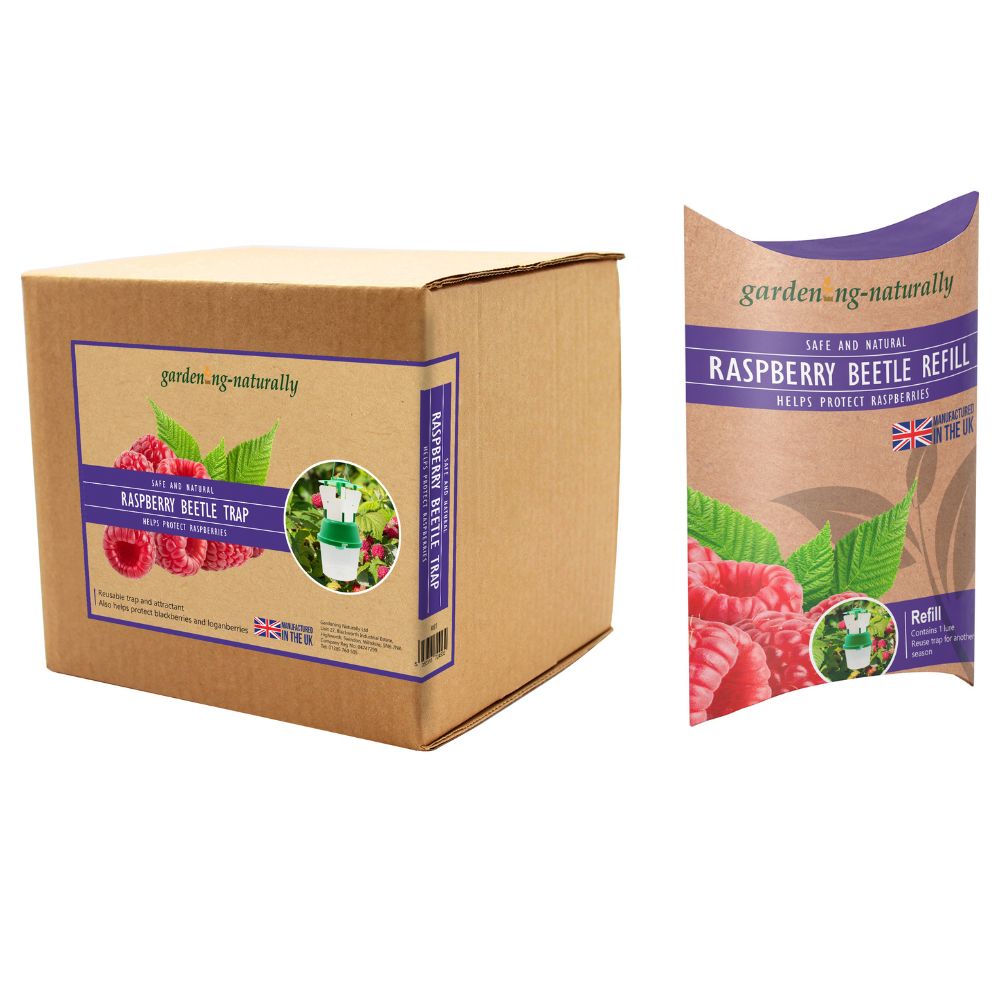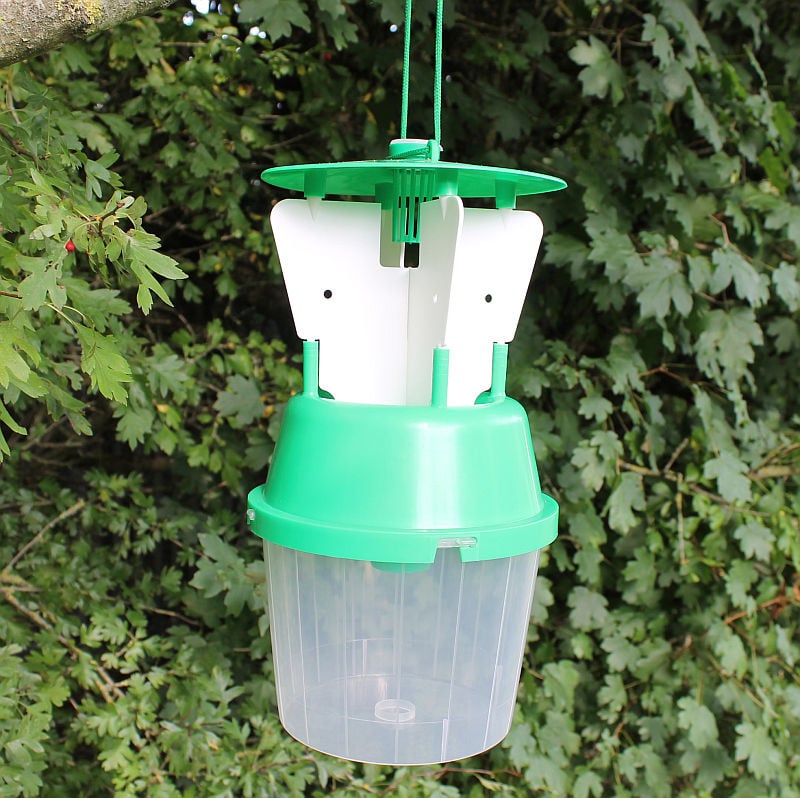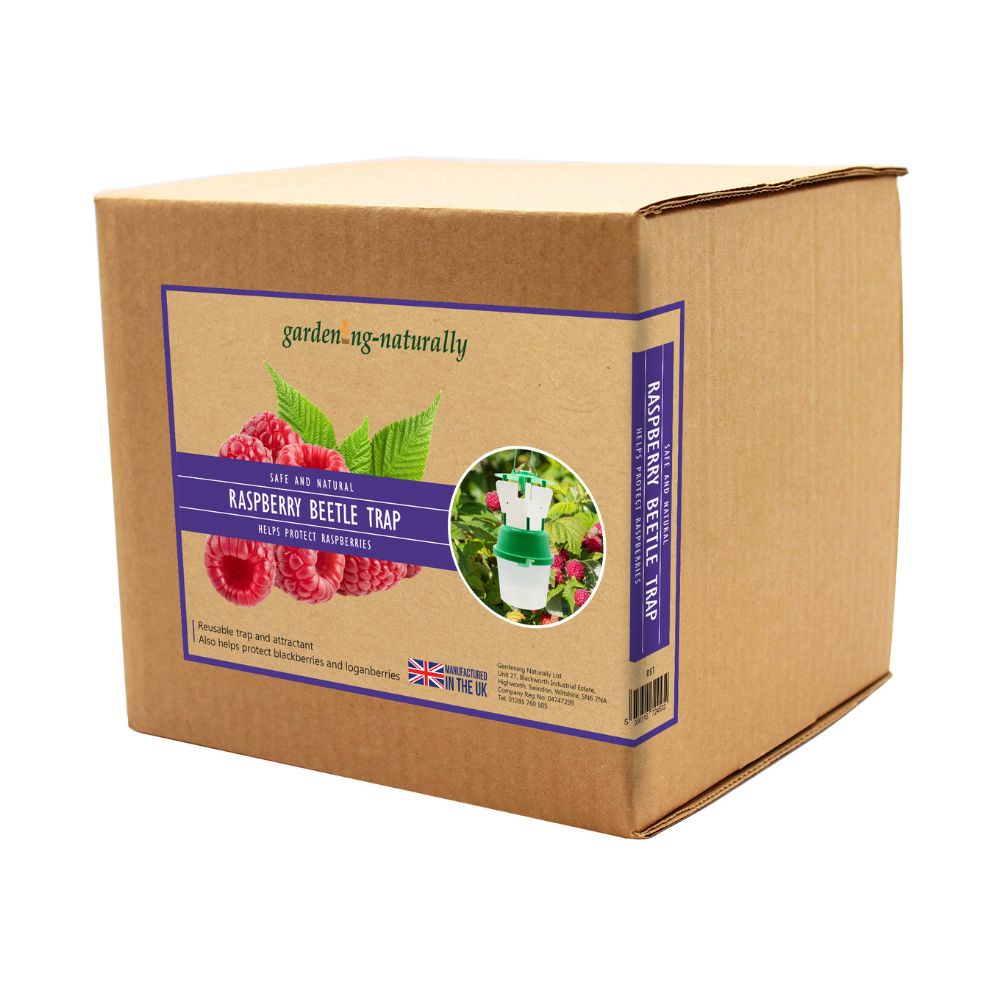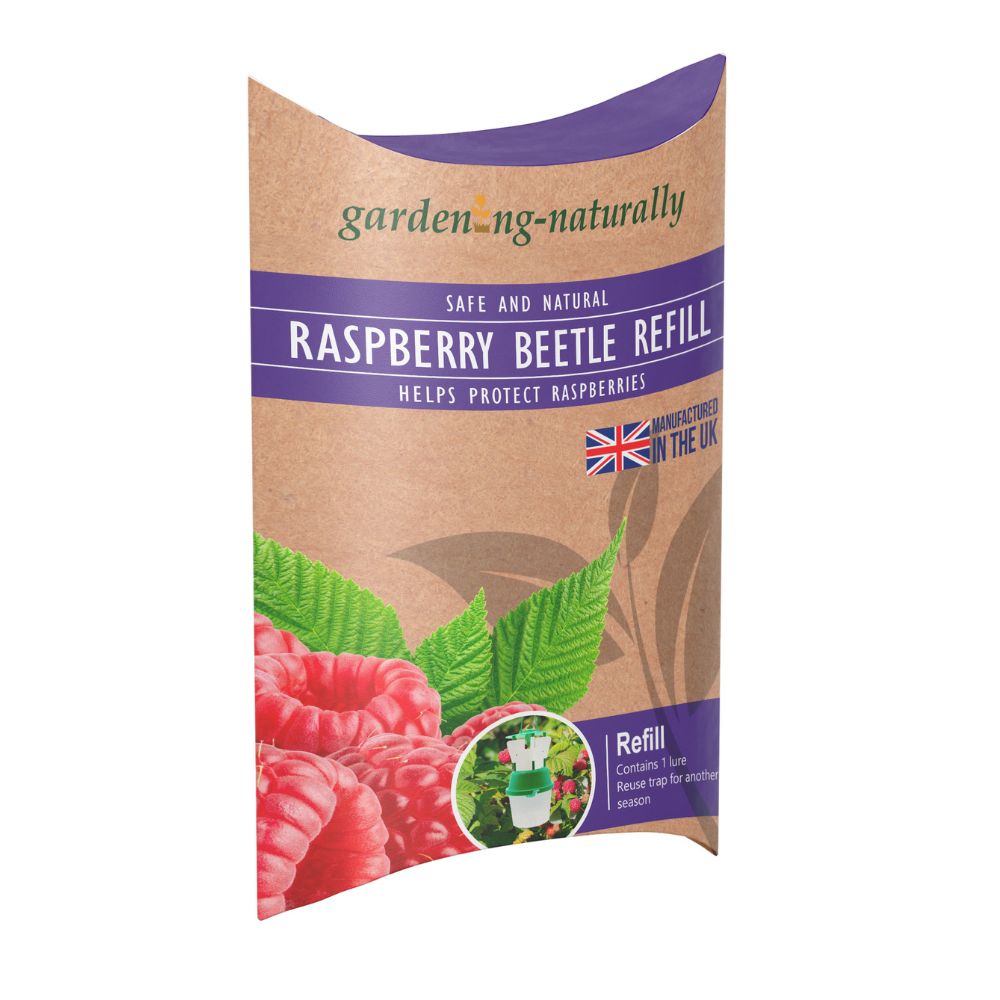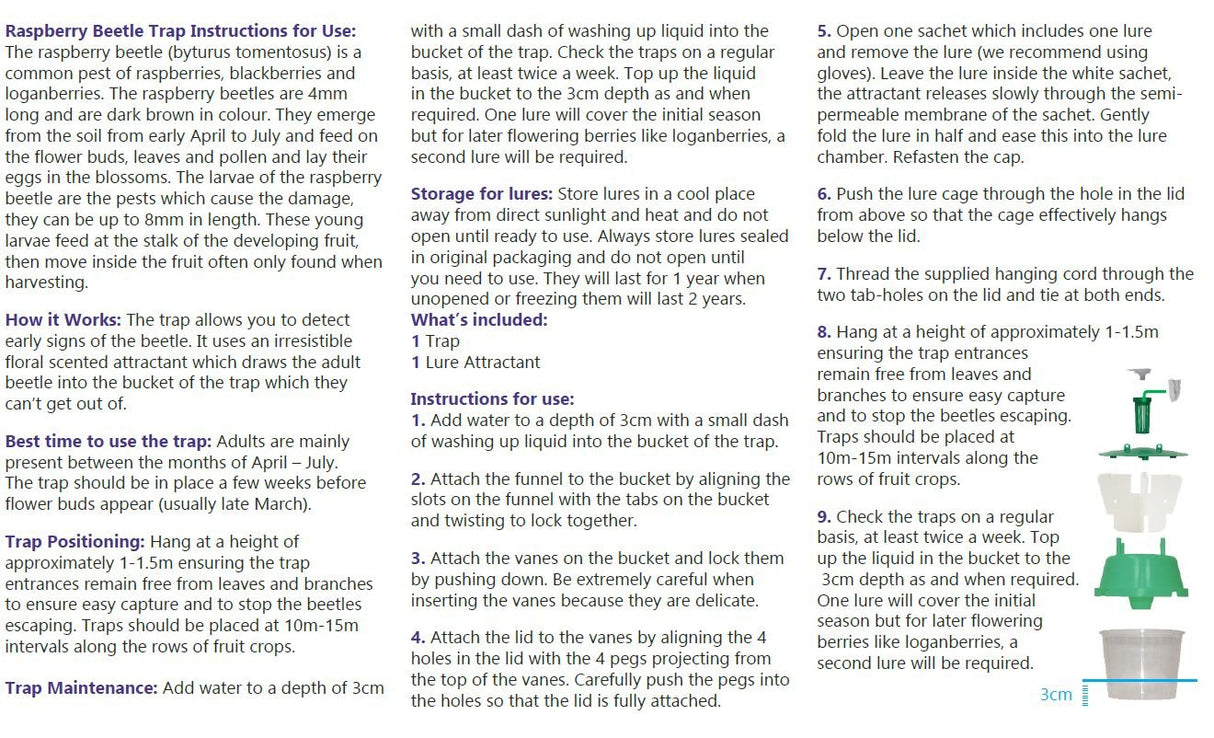Raspberry Beetle Trap For Raspberries, Blackberries And Loganberries
Raspberry Beetle Trap For Raspberries, Blackberries And Loganberries - Trap is backordered and will ship as soon as it is back in stock.
The raspberry beetle trap is designed to detect raspberry beetle (Byturus tomentosus), a common pest that affects raspberries, blackberries and loganberries. This trap attracts and captures adult beetles before they can lay eggs in developing fruit, helping to reduce crop damage during the growing season.
Raspberry Beetle Trap With Floral Attractant Lure
The raspberry beetle trap uses a funnel design combined with a floral attractant lure to draw beetles as they emerge from the soil. The large off-white vanes act as a strong visual cue, imitating a raspberry flower and attracting beetles directly into the trap. This simple system helps protect crops by capturing the adult beetles early in the season.
How The Raspberry Beetle Trap Works
Adult beetles overwinter in the soil and appear from April to June. They feed on buds and pollen before laying eggs in flowers. The larvae then feed inside the developing fruit. Position the trap 1–1.5m above ground and set it up 4–6 weeks before flowering, between April and July. Each trap covers an area of up to 50 square metres.
Replacement Lures For Raspberry Beetle Traps
Each raspberry beetle trap includes an attractant lure that lasts approximately six weeks. For a full raspberry season, two lures are recommended. For later flowering crops such as loganberries or autumn-fruiting raspberries, a second lure should be used to maintain protection.
Available Raspberry Beetle Trap Kits And Refills
The traps are available in several pack options:
- Raspberry Beetle Trap – Includes 1 trap and 1 attractant lure
- Refill – Includes 1 attractant lure
- Trap And Refill – Includes 1 trap and 2 attractant lures
Store unused lures in a cool, dry place away from sunlight. Keep them sealed in their original packaging until required. Unopened lures will last up to two years.
Protecting Raspberries And Other Soft Fruit From Beetle Damage
Using the raspberry beetle trap helps detect early infestations and reduce larvae inside developing fruit. By placing traps before flowering, you can intercept adult beetles before they lay eggs. This method is ideal for use in both home gardens and commercial soft fruit plots.
When Should I Put Out The Raspberry Beetle Trap?
Set up traps 4–6 weeks before flowering, typically from April to May, to catch adult beetles as they emerge from the soil.
How Many Raspberry Beetle Traps Do I Need?
Each trap protects an area of approximately 50 square metres. Larger gardens or allotments may need multiple traps for full coverage.
Can The Trap Be Used For Other Soft Fruit?
Yes, the trap is suitable for use with raspberries, blackberries and loganberries, all of which can be affected by the raspberry beetle.
How Long Does The Attractant Lure Last?
Each lure remains active for around six weeks. Replace it once per normal raspberry season or twice for longer cropping varieties.
Where Should I Store The Lures When Not In Use?
Keep lures sealed in their original packaging and store them in a cool, dry place away from direct sunlight and heat sources.
How Does The Raspberry Beetle Trap Help Protect Crops?
The trap reduces beetle populations by attracting and capturing adults before they can lay eggs, helping to prevent larvae from damaging developing fruit.
Reviews
Reviews
Specifications
Specifications
Raspberry Beetle Trap includes:
1 x Trap
1 x Lure
Refill:
1 x Lure
Trap and Refill:
1 x Trap
2 x Lure
How To Use
How To Use
How it Works: The trap allows you to detect early signs of the beetle. It uses an irresistible floral scented attractant which draws the adult beetle into the bucket of the trap which they can’t get out of.
Best time to use the trap: Adults are mainly present between the months of April – July. The trap should be in place a few weeks before flower buds appear (usually late March).
Trap Positioning: Hang at a height of approximately 1-1.5m ensuring the trap entrances remain free from leaves and branches to ensure easy capture and to stop the beetles escaping. Traps should be placed at 10m-15m intervals along the rows of fruit crops.
Trap Maintenance: Add water to a depth of 3cm with a small dash of washing up liquid into the bucket of the trap. Check the traps on a regular basis, at least twice a week. Top up the liquid in the bucket to the 3cm depth as and when required. One lure will cover the initial season but for later flowering berries like loganberries, a second lure will be required.
Storage for lures: Store lures in a cool place away from direct sunlight and heat and do not open until ready to use. Always store lures sealed in original packaging and do not open until you need to use. They will last for 1 year when unopened or freezing them will last 2 years.
Instructions for use:
1. Add water to a depth of 3cm with a small dash of washing up liquid into the bucket of the trap.
2. Attach the funnel to the bucket by aligning the slots on the funnel with the tabs on the bucket and twisting to lock together.
3. Attach the vanes on the bucket and lock them by pushing down. Be extremely careful when inserting the vanes because they are delicate.
4. Attach the lid to the vanes by aligning the 4 holes in the lid with the 4 pegs projecting from the top of the vanes. Carefully push the pegs into the holes so that the lid is fully attached.
5. Open one sachet which includes one lure and remove the lure (we recommend using gloves). Leave the lure inside the white sachet, the attractant releases slowly through the semi-permeable membrane of the sachet. Gently fold the lure in half and ease this into the lure chamber. Refasten the cap.
6. Push the lure cage through the hole in the lid from above so that the cage effectively hangs below the lid.
7. Thread the supplied hanging cord through the two tab-holes on the lid and tie at both ends.
8. Hang at a height of approximately 1-1.5m ensuring the trap entrances remain free from leaves and branches to ensure easy capture and to stop the beetles escaping. Traps should be placed at 10m-15m intervals along the rows of fruit crops.
9. Check the traps on a regular basis, at least twice a week. Top up the liquid in the bucket to the 3cm depth as and when required. One lure will cover the initial season but for later flowering berries like loganberries, a second lure will be required.
More Information
More Information
How it Works: The trap allows you to detect early signs of the beetle. It uses an irresistible floral scented attractant which draws the adult beetle into the bucket of the trap which they can’t get out of. Best time to use the trap: Adults are mainly present between the months of April – July. The trap should be in place a few weeks before flower buds appear (usually late March). Trap Positioning: Hang at a height of approximately 1-1.5m ensuring the trap entrances remain free from leaves and branches to ensure easy capture and to stop the beetles escaping. Traps should be placed at 10m-15m intervals along the rows of fruit crops. Trap Maintenance: Add water to a depth of 3cm with a small dash of washing up liquid into the bucket of the trap. Check the traps on a regular basis, at least twice a week. Top up the liquid in the bucket to the 3cm depth as and when required. One lure will cover the initial season but for later flowering berries like loganberries, a second lure will be required. Storage for lures: Store lures in a cool place away from direct sunlight and heat and do not open until ready to use. Always store lures sealed in original packaging and do not open until you need to use. They will last for 1 year when unopened or freezing them will last 2 years.
